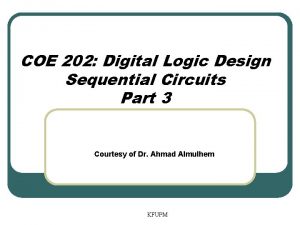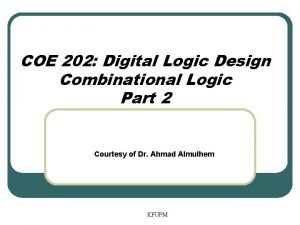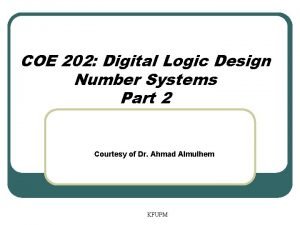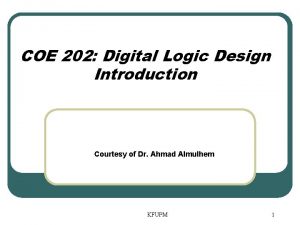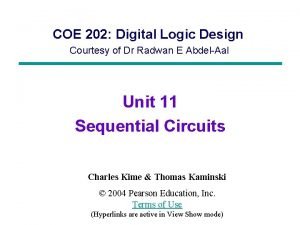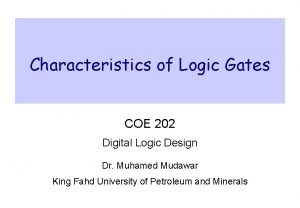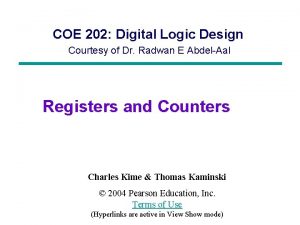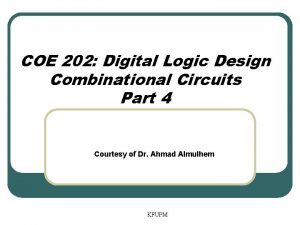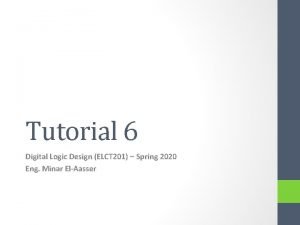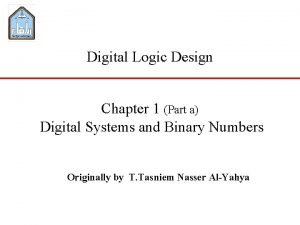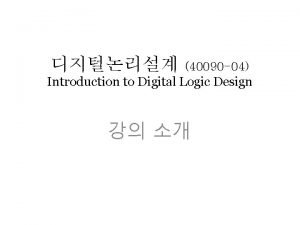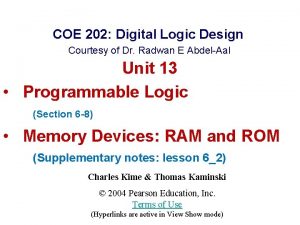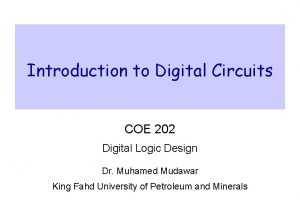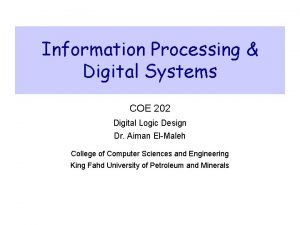COE 202 Digital Logic Design Introduction Courtesy of



















- Slides: 19

COE 202: Digital Logic Design Introduction Courtesy of Dr. Ahmad Almulhem KFUPM 1

Objectives 1. 2. 3. 4. 5. Digital Systems “Analog” versus “Digital” parameters and systems. Digitization of “Analog” signals. Digital representation of information. Effect of noise on the reliability and choice of digital system representation. KFUPM 2

Digital Systems • Digital Systems exist everywhere • Communication, banks, hospitals, Internet etc. • Computers are digital systems • Programmable, flexible KFUPM 3

Digital vs. Analog Systems We live in an analog world (continuous) Analog signals are continuous in nature • Smooth transition over a period of time • Represent a physical quantity or phenomenon • E. g. temperature of a cup of tea being boiled Kettle removed from stove 100 o. C temperature time KFUPM 4

Digital vs. Analog Systems Digital signals are non-continuous i. e. discrete • • Consist of fixed set of digits. E. g. number of months in a year = 12; digits = {1, 2, 3, …. , 10, 11, 12} note that 11. 3 or 4. 9 are invalid here. Abrupt transition (jumping) from one digit to another 1 2 3 4 5 6 7 8 9 10 11 12 Value Jan Feb Mar Apr May Jun Jul Aug KFUPM Sep Oct Nov Dec 5

Digital vs. Analog Systems Q: Digital or Analog? • • • Earth movement English letters Internet IP addresses Human voice Week days KFUPM 6

Digitization Process of conversion from analog to digital is called digitization Analog to digital (ADC) converters perform digitization Digital to analog (DAC) converters regenerate the analog signals from their digitized form KFUPM 7

Digitization (Why? ) The world around us is analog Digital systems are simple to understand & comprehend Thus …. Common practice is to convert analog signals into digital form for efficient processing of signals Inevitable to avoid loss of some accuracy (information) due to this conversion Reason: digital systems can only represent fixed (finite or discrete) set of values KFUPM 8

Analog to Digital to Analog KFUPM 9

Digitization Example KFUPM 10

Digitization Example The digital signal can contain a combination of only one of four voltage values – V 1, V 2, V 3, V 4 Analog values are mapped to the closest discrete voltage value KFUPM 11

Computers are digital systems Deal with a vocabulary of two elements namely 0 and 1 – also known as the binary system of numbers Binary digits i. e. 0 and 1 are called bits Decimal digits 0, 1, 2, 3, …. , 9 are simply called ‘digits’ – these digits constitute the decimal number system 1 1 0 KFUPM 12

Data representation Computers represent data (V 1, V 2, V 3, V 4) in binary system using: • Electrical voltages (processors, memory) • Magnetism (hard disks, floppy) • Light (CD, DVD) KFUPM 13

Signal representation (Voltage) Computers use low power supply voltage, typically from 0 V to 5 V In decimal numbering system, the voltage levels are divided into 10 equal parts. Therefore: • • • 0 represents 0 – 0. 5 V 1 represents 0. 5 – 1. 0 V 2 represents 1. 0 -1. 5 V and so forth. Only 0. 5 V separate two consecutive voltage ranges if decimal digits are used. KFUPM 14

Signal representation (Voltage) Using the binary system, as is the case with all computers, and a low power voltage range from 0 -5 V • A binary ‘ 0’ is represented with 0 Volts • A binary ‘ 1’ is represented with 5 Volts A larger range of Volts differentiate between the two values (0 and 1) in the binary system KFUPM 15

Signal representation (Voltage) KFUPM 16

Noise exists in environments (mobile & TV) Noise can change voltage level (higher or lower) KFUPM 17

Noise exists in the environment Causes disruption in the voltage levels. If the range of differentiation between consecutive values is low, the data can be disrupted Example: 1. 6 V (represented using decimal digit 3) when transmitted in a noisy environment becomes 1. 5 V (i. e. decimal digit 2), thus corrupting the data Conclusion: Digital systems (using binary digits) are more reliable than the decimal system KFUPM 18

Conclusions Information can be represented using analog and digital form Processing of digital data is flexible, reliable, simple and powerful Computers represent data using the binary system Digitization of data (converting from analog to digital) Next Lecture: Numbering systems (representation and manipulation) KFUPM 19
